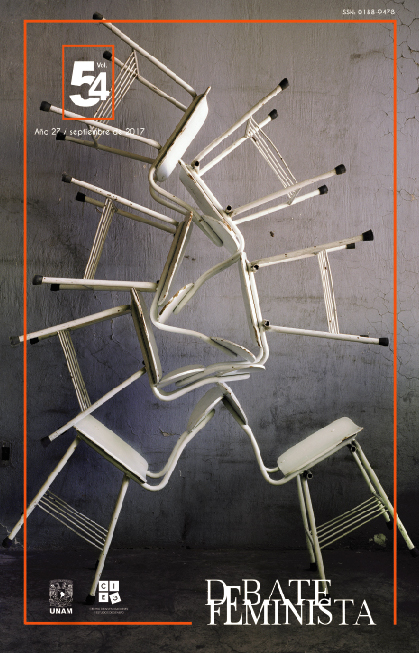Vidas inimagináveis: governamentalidade e mídialidade na prevenção do HIV/AIDS
Conteúdo do artigo principal
Resumo
No presente estudo comparamos materiais visuais de prevenção do HIV usados em quatro países (Alemanha, Brasil, Estados Unidos e México) entre 1985 e 2005. Baseados simultaneamente nos quadros teóricos de medicalização, governamentalidade e estudos de mídia, analisamos as formas em que diferentes subjetividades são construídas, representadas, estruturadas e controladas. Entre outros resultados notáveis, este estudo comparativo propõe novas perspectivas sobre os vários discursos implementados em cada país para abordar o HIV como fenômeno bio-social; por exemplo, a invisibilidade seletiva de sectores vulneráveis ou as várias estratégias para lidar com os contextos sociopolíticos particulares de cada um. Tais peculiaridades podem-se considerar um dos alicerces para a construção de interseccionalidades.
Detalhes do artigo

Este trabalho está licenciado sob uma licença Creative Commons Attribution-NonCommercial-NoDerivatives 4.0 International License.
Esta es una publicación bajo la licencia Creative Commons Attribution-Non Commercial-No Derivatives 4.0 International (CC BY-NC- ND 4.0). Para mayor información sobre el uso no comercial de los contenidos que aquí aparecen, favor de consultar http://creativecommons.org/licenses/by-nc-nd/4.0/
Referências
Airhihenbuwa, C. y Obregon, R. (2000). A critical assessment of theories/models used in health communication for HIV/AIDS. Journal of Health Communication, 5(Suppl), 5–15.
Brennen, B.S. (2013). Qualitative Research Methods for Media Studies. Nueva York, NY: Routledge.
Clarke, A.E., Shim, J.K., Mamo, L., Fosket, J.R. y Fishman, J.R. (2003). Biomedicalization: Technoscientific transformations of health, illness, and U.S. biomedicine. American Sociological Review, 68(2), 161–194.
Clarke, A.E. y Shim, J. (2011). Medicalization and biomedicalization revisited: Technoscience and transformations of health, illness and America medicine. En B. Pescosolido, J. Martin, J. McLeod, y A. Rogers (Eds.), Handbook of the Sociology of Health, Illness, and Healing: A Blueprint for the 21st Century (pp. 173–199). Estados Unidos: Springer.
Conrad, P. y Angell, A. (2004). Homosexuality and remedicalization. Society, 41(5), 32–39.
Conrad, P. y Schneider, J.W. (1992). Deviance and Medicalization: From Badness to Sickness. Philadelphia: Temple University Press.
Conrad, P. (2005). The shifting engines of medicalization. Journal of Health and Social Behavior, 46(1), 3–14.
Conrad, P. (2007). The medicalization of society: On the transformation of human conditions into treatable disorders. Baltimore, Maryland: Johns Hopkins University Press.
Crawford, R. (2004). Risk ritual and the management of control and anxiety in medical culture. Health, 8(4), 505–528.
Epstein, S. (1996). Impure Science; AIDS Activism and the Politics of Knowledge. Berkeley, CA: University of California Press.
Foucault, M. y Marchetti, V. (2001). Los anormales. Barcelona: Akal.
Gillett, J. (2003). Media activism and internet use by people with HIV/AIDS. Sociology of Health & Illness, 25(6), 608–624.
Guerrero McManus, F. (2015). Ciencia y contracultura: El Movimiento de Liberación Homosexual y sus saberes. Ludus Vitalis, 23(43), 195–221.
Guerrero McManus, F. (2016). Medicalización, globalidad y coproducción en Latinoamérica y Angloamérica. En G. Mateos y E. Suárez (Eds.), Aproximaciones a lo Local y lo Global: América Latina en la Historia de la Ciencia Contemporánea (pp. 323-354). México: Estudio de Centros Filosóficos, Políticos y Sociales Vicente Lombardo Toledano.
Hacking, I. (2002). Historical Ontology. Cambridge, Massachusetts: Harvard University Press.
Hall, S. (2012). Encoding/Decoding. En Durham, Meenakshi, y Douglas Kellner (Eds.), Media and Cultural Studies. Keyworks (pp. 137–144). Oxford: Wiley-Blackwell.
Hentschel, K. (2014). Visual Cultures in Science and Technology. A Comparative History. Oxford: Oxford University Press.
Kippax, S. (2010). Reasserting the social in a biomedical epidemic: The case of HIV-Prevention. En Conference on Reframing the Social Dimensions of HIV in a Biomedicalised Epidemic: The Case of Treatment as Prevention.
Lupton, D. (1994). Moral threats and dangerous desires: AIDS in the news media. London: Taylor and Francis.
Matic, S., Lazarus, J., Donoghoe, M. (2006). HIV/AIDS in Europe. Moving from Death Sentence to Chronic Disease Management. Copenhagen: World Health Organization [consultado 3 Dic 2016]. Disponible en: http://www.who.int/hiv/pub/idu/hiveurope.pdf
McManus, F. y Mercado-Reyes, A. (2016). Constructing publics, preventing diseases and medicalizing bodies: HIV, AIDS, and its visual cultures. Sexualidad, Salud y Sociedad - Revista Latinoamericana, 24, 69–102.
Nguyen, V., O’Malley, J. y Pirkle, C.M. (2011). Remedicalizing an epidemic: From HIV treatment as prevention to HIV treatment is prevention. AIDS, 25(11), 1435.
Nguyen, V. (2007). Antiretroviral Globalism, Biopolitics, and Therapeutic Citizenship. En A. Ong y S.J. Collier (Eds.), Global Assemblages: Technology, Politics, and Ethics as Anthropological Problems. Oxford: Blackwell Publishing Ltd.
ONUSIDA (2000). Report on the HIV/AIDS Epidemic, June 2000. Ginebra.
ONUSIDA (2004). Epidemiological Fact Sheets on HIV/AIDS and sexually transmitted infections. Germany [consultado 3 Dic 2016]. Disponible en: http://data.unaids.org/publications/fact-sheets01/germanyen.pdf
ONUSIDA (2012). Global Aids Response Country Progress Report Germany [consultado 3 Dic 2016]. Disponible en: http://www.unaids.org/sites/default/files/country/documents//file%2C68503%2Ces.pdf
Rajan, K.S. (2006). Biocapitalism: The Constitution of Post-Genomic Life. Durham: Duke University Press.
Rose, N. (2009). The Politics of Life Itself: Biomedicine, Power and Subjectivity in the Twenty-First Century. Nueva Jersey: Princeton University Press.
Rose, N., O’Malley, P. y Valverde, M. (2006). Governmentality. Annual Review of Law and Social Science, 2, 83–104.
Smallman, S. (2007). The AIDS Pandemic in Latin America. Chapel Hill: The University of North Carolina Press.
Treichler, P. (1987). AIDS, homophobia and biomedical discourse: An epidemic of signification. Cultural Studies, 1(3), 263–305.
Páginas de internet:
http://aidsinfo.unaids.org/ [consultada 3 Dic 2016].
Centro de Control de Enfermedades: https://www.cdc.gov/mmwr/preview/mmwrhtml/mm5021a2.htm [consultada 27 Nov 2016].







